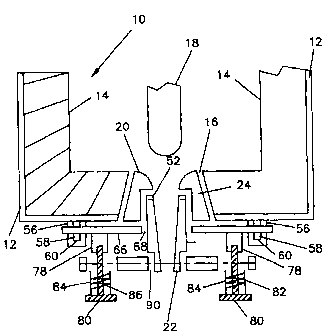Some of the information on this Web page has been provided by external sources. The Government of Canada is not responsible for the accuracy, reliability or currency of the information supplied by external sources. Users wishing to rely upon this information should consult directly with the source of the information. Content provided by external sources is not subject to official languages, privacy and accessibility requirements.
Any discrepancies in the text and image of the Claims and Abstract are due to differing posting times. Text of the Claims and Abstract are posted:
| (12) Patent: | (11) CA 2308469 |
|---|---|
| (54) English Title: | REFRACTORY NOZZLE |
| (54) French Title: | BUSE REFRACTAIRE |
| Status: | Expired and beyond the Period of Reversal |
| (51) International Patent Classification (IPC): |
|
|---|---|
| (72) Inventors : |
|
| (73) Owners : |
|
| (71) Applicants : |
|
| (74) Agent: | SMART & BIGGAR LP |
| (74) Associate agent: | |
| (45) Issued: | 2010-04-13 |
| (86) PCT Filing Date: | 1999-09-01 |
| (87) Open to Public Inspection: | 2000-03-16 |
| Examination requested: | 2004-08-04 |
| Availability of licence: | N/A |
| Dedicated to the Public: | N/A |
| (25) Language of filing: | English |
| Patent Cooperation Treaty (PCT): | Yes |
|---|---|
| (86) PCT Filing Number: | PCT/GB1999/002877 |
| (87) International Publication Number: | WO 2000013822 |
| (85) National Entry: | 2000-05-03 |
| (30) Application Priority Data: | ||||||
|---|---|---|---|---|---|---|
|
A refractory nozzle comprises upper and
lower members (20 and 22) having matching
tapered bores. The members fit together so
that the bores match, and are secured in the
hole (16) in the bottom of a metallurgical
vessel by a retaining plate (66) and a bottom
plate (86). The bottom plate (86) can be
removed to allow the lower member (22) to be
replaced without disturbing the upper member.
Cette buse réfractaire est constituée d'un élément supérieur (20) et d'un élément inférieur (22) présentant des perçages coniques complémentaires. Ces éléments, qui s'adaptent l'un sur l'autre de façon que les perçages coïncident, sont bloqués dans le trou (16) du fond du récipient métallurgique par une platine de retenue (66) et une platine de fond (86). Cette platine de fond (86) peut être déposée de façon à permettre le remplacement de l'élément inférieur (22) sans avoir à intervenir sur l'élément supérieur.
Note: Claims are shown in the official language in which they were submitted.
Note: Descriptions are shown in the official language in which they were submitted.

2024-08-01:As part of the Next Generation Patents (NGP) transition, the Canadian Patents Database (CPD) now contains a more detailed Event History, which replicates the Event Log of our new back-office solution.
Please note that "Inactive:" events refers to events no longer in use in our new back-office solution.
For a clearer understanding of the status of the application/patent presented on this page, the site Disclaimer , as well as the definitions for Patent , Event History , Maintenance Fee and Payment History should be consulted.
| Description | Date |
|---|---|
| Time Limit for Reversal Expired | 2018-09-04 |
| Change of Address or Method of Correspondence Request Received | 2018-01-12 |
| Letter Sent | 2017-09-01 |
| Grant by Issuance | 2010-04-13 |
| Inactive: Cover page published | 2010-04-12 |
| Inactive: Final fee received | 2010-01-28 |
| Pre-grant | 2010-01-28 |
| Notice of Allowance is Issued | 2009-08-25 |
| Letter Sent | 2009-08-25 |
| Notice of Allowance is Issued | 2009-08-25 |
| Inactive: Approved for allowance (AFA) | 2009-07-29 |
| Amendment Received - Voluntary Amendment | 2009-03-26 |
| Inactive: S.30(2) Rules - Examiner requisition | 2008-12-16 |
| Amendment Received - Voluntary Amendment | 2008-05-13 |
| Inactive: S.30(2) Rules - Examiner requisition | 2008-04-10 |
| Letter Sent | 2004-08-24 |
| Request for Examination Received | 2004-08-04 |
| Request for Examination Requirements Determined Compliant | 2004-08-04 |
| All Requirements for Examination Determined Compliant | 2004-08-04 |
| Inactive: Cover page published | 2000-07-04 |
| Inactive: First IPC assigned | 2000-06-25 |
| Inactive: Notice - National entry - No RFE | 2000-06-21 |
| Inactive: Inventor deleted | 2000-06-19 |
| Application Received - PCT | 2000-06-16 |
| Application Published (Open to Public Inspection) | 2000-03-16 |
There is no abandonment history.
The last payment was received on 2009-08-17
Note : If the full payment has not been received on or before the date indicated, a further fee may be required which may be one of the following
Please refer to the CIPO Patent Fees web page to see all current fee amounts.
Note: Records showing the ownership history in alphabetical order.
| Current Owners on Record |
|---|
| STEPHEN DAVID MILLS |
| Past Owners on Record |
|---|
| None |